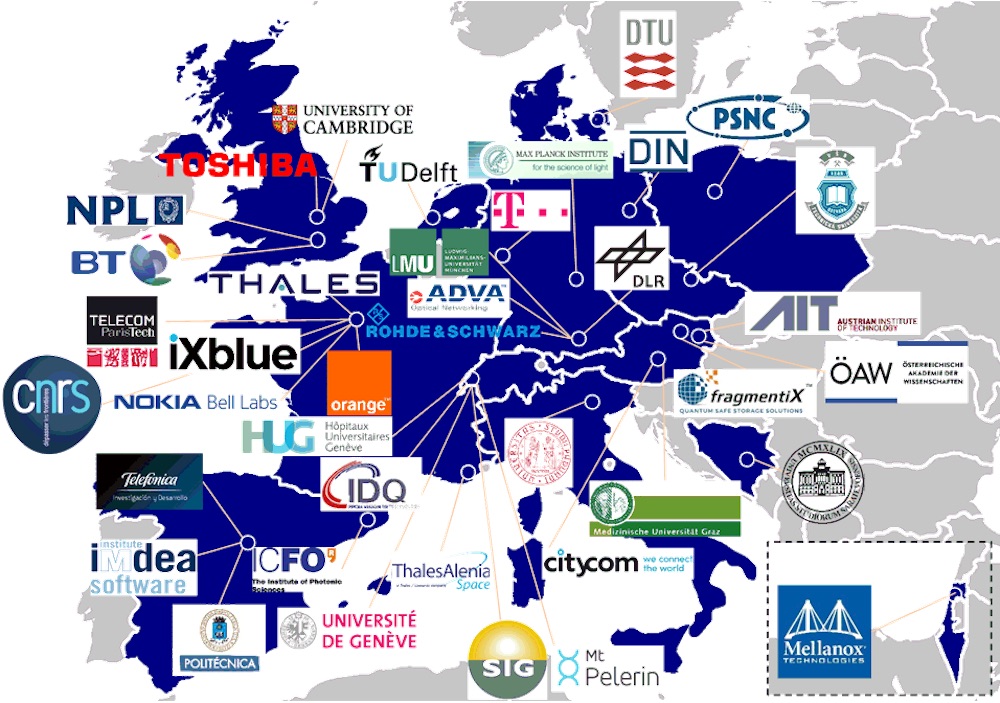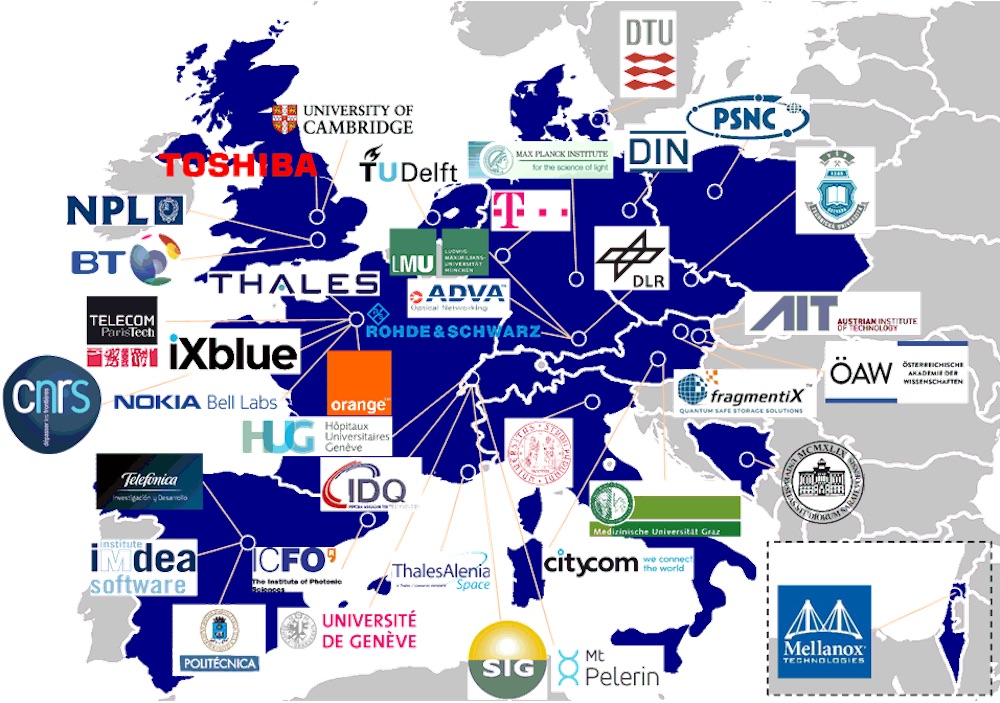
OpenQKD Consortium
For this €15 million project, the European Union has selected 38 companies and research institutes across the continent, including four Swiss organizations all from Geneva: University of Geneva, Services Industriels de Genève, ID Quantique and Mt Pelerin.
OPENQKD aims to change the way we see, understand and use quantum communication. Its main focus is to create and test communication network infrastructures with a built-in quantum element, known as Quantum Key Distribution (QKD). The secret keys distributed through QKD enable an ultra-secure form of encryption that allows data to be transmitted with a very high level of security. It will lay the groundwork for a pan-European quantum communication infrastructure that uses satellite as well as ground-based solutions.
Building closer European links
The Europe Commission chose to fund OPENQKD following a Horizon 2020 call for proposals in 2018. Its mission is to develop experimental testbeds based on QKD and to test the interoperability of equipment supplied by different manufacturers of quantum systems among which ID Quantique (IDQ), the global leader in quantum communications and quantum sensing, based in Switzerland. The University of Geneva (UNIGE) will supply a new generation QKD prototype, taking advantage of their latest developments. OPENQKD’s activities will take place all over Europe (in Austria, Spain, Poland, Germany, Netherlands, Switzerland, France, Italy, UK, Greece and the Czech Republic).
It will focus on several key fields of operations, especially the telecommunications sector, where data security is critical. Other applications, such as securing medical, governmental or energy grid data will also be demonstrated and evaluated.
Four use cases in Geneva
As part of Open QKD, ID Quantique (IDQ), the manufacturer of quantum communication solutions; the Services Industriels de Genève (SIG), Geneva’s provider of energy, water, optical fibers and waste-treatment networks; Mt Pelerin, the Swiss leader in blockchain technology for banking and finance; and the University of Geneva are work- ing together on at least four uses cases which will be implemented in Geneva. For this purpose they take profit from the dense and versatile network of optical fibres of SIG.
1. Quantum Vault:
The Quantum Vault is a new kind of Digital Asset Custody system designed by Mt Pelerin in cooperation with ID Quantique. Earlier in June, ID Quantique announced its partnership with Mt Pelerin.
This custody infrastructure aims at providing ultra-secure storage of digital assets by financial institutions such as central banks, global custodians, cryptocurrency exchanges, and asset managers.
The Quantum Vault relies on a QKD infrastructure provided by IDQ and transported over the SIG network. By adding this extra layer of quantum-safe security on top of a bank-grade custody solution, the Quantum Vault ensures that the safe storage of private keys (the proof of a digital asset’s ownership) is “Information-Theoretically Secure” (ITS). ITS means that according to information theory, such a system cannot be hacked by an external adversary even with unlimited computing power.
2. Smart Grid:
Over the next seven years, SIG will create a smart grid network to connect its 800 power stations in Geneva. Each power station will be connected to the SIG telecom optical fiber network and to SIG’s electricity network operations center. To secure data transmission and detection intrusion (hackers taking control of the electricity distribution network), SIG will test quantum technology provided by IDQ in a real production and operational environment. To this end, SIG will connect five power stations to the QKD testbed and assess available QKD technologies and services offered by the consortium.
3. Secured Datacenter Replication:
SIG intends to implement a quantum-safe solution between 2 main datacenters used as primary / backup. Data replication, fail over and load balancing imply the transfer of a large amount of highly sensitive data. Communication will be secured though QKD, with two nodes being deployed. This use case will focus on demonstrating high avail- ability, high performance and failover solutions.
4. Encryption for Long Term Storage:
Encryption is more and more often required for securing critical data. This is particularly the case for user electronic data like the one of hospital patient frequently encrypted. As such storage is long term (10 years at least, possibly during the patients’ lifetimes), it is key to use state-of-the-art technologies. The University of Geneva will be evalu- ating the use of QKD for strong and long-term encryption by measuring the delay to re-encrypt data due to key or algorithm change.
With this testbed in Geneva and its corresponding use-cases, OPENQKD will develop an innovation ecosystem and training ground as well as help to grow the technology and solution supply chains for quantum communication technologies and services.
OPENQKD aims to change the way we see, understand and use quantum communication. Its main focus is to create and test communication network infrastructures with a built-in quantum element, known as Quantum Key Distribution (QKD). The secret keys distributed through QKD enable an ultra-secure form of encryption that allows data to be transmitted with a very high level of security. It will lay the groundwork for a pan-European quantum communication infrastructure that uses satellite as well as ground-based solutions.
Building closer European links
The Europe Commission chose to fund OPENQKD following a Horizon 2020 call for proposals in 2018. Its mission is to develop experimental testbeds based on QKD and to test the interoperability of equipment supplied by different manufacturers of quantum systems among which ID Quantique (IDQ), the global leader in quantum communications and quantum sensing, based in Switzerland. The University of Geneva (UNIGE) will supply a new generation QKD prototype, taking advantage of their latest developments. OPENQKD’s activities will take place all over Europe (in Austria, Spain, Poland, Germany, Netherlands, Switzerland, France, Italy, UK, Greece and the Czech Republic).
It will focus on several key fields of operations, especially the telecommunications sector, where data security is critical. Other applications, such as securing medical, governmental or energy grid data will also be demonstrated and evaluated.
Four use cases in Geneva
As part of Open QKD, ID Quantique (IDQ), the manufacturer of quantum communication solutions; the Services Industriels de Genève (SIG), Geneva’s provider of energy, water, optical fibers and waste-treatment networks; Mt Pelerin, the Swiss leader in blockchain technology for banking and finance; and the University of Geneva are work- ing together on at least four uses cases which will be implemented in Geneva. For this purpose they take profit from the dense and versatile network of optical fibres of SIG.
1. Quantum Vault:
The Quantum Vault is a new kind of Digital Asset Custody system designed by Mt Pelerin in cooperation with ID Quantique. Earlier in June, ID Quantique announced its partnership with Mt Pelerin.
This custody infrastructure aims at providing ultra-secure storage of digital assets by financial institutions such as central banks, global custodians, cryptocurrency exchanges, and asset managers.
The Quantum Vault relies on a QKD infrastructure provided by IDQ and transported over the SIG network. By adding this extra layer of quantum-safe security on top of a bank-grade custody solution, the Quantum Vault ensures that the safe storage of private keys (the proof of a digital asset’s ownership) is “Information-Theoretically Secure” (ITS). ITS means that according to information theory, such a system cannot be hacked by an external adversary even with unlimited computing power.
2. Smart Grid:
Over the next seven years, SIG will create a smart grid network to connect its 800 power stations in Geneva. Each power station will be connected to the SIG telecom optical fiber network and to SIG’s electricity network operations center. To secure data transmission and detection intrusion (hackers taking control of the electricity distribution network), SIG will test quantum technology provided by IDQ in a real production and operational environment. To this end, SIG will connect five power stations to the QKD testbed and assess available QKD technologies and services offered by the consortium.
3. Secured Datacenter Replication:
SIG intends to implement a quantum-safe solution between 2 main datacenters used as primary / backup. Data replication, fail over and load balancing imply the transfer of a large amount of highly sensitive data. Communication will be secured though QKD, with two nodes being deployed. This use case will focus on demonstrating high avail- ability, high performance and failover solutions.
4. Encryption for Long Term Storage:
Encryption is more and more often required for securing critical data. This is particularly the case for user electronic data like the one of hospital patient frequently encrypted. As such storage is long term (10 years at least, possibly during the patients’ lifetimes), it is key to use state-of-the-art technologies. The University of Geneva will be evalu- ating the use of QKD for strong and long-term encryption by measuring the delay to re-encrypt data due to key or algorithm change.
With this testbed in Geneva and its corresponding use-cases, OPENQKD will develop an innovation ecosystem and training ground as well as help to grow the technology and solution supply chains for quantum communication technologies and services.




 IonQ Achieves Industry Leading Performance on Next Generation Barium Qubits
IonQ Achieves Industry Leading Performance on Next Generation Barium Qubits